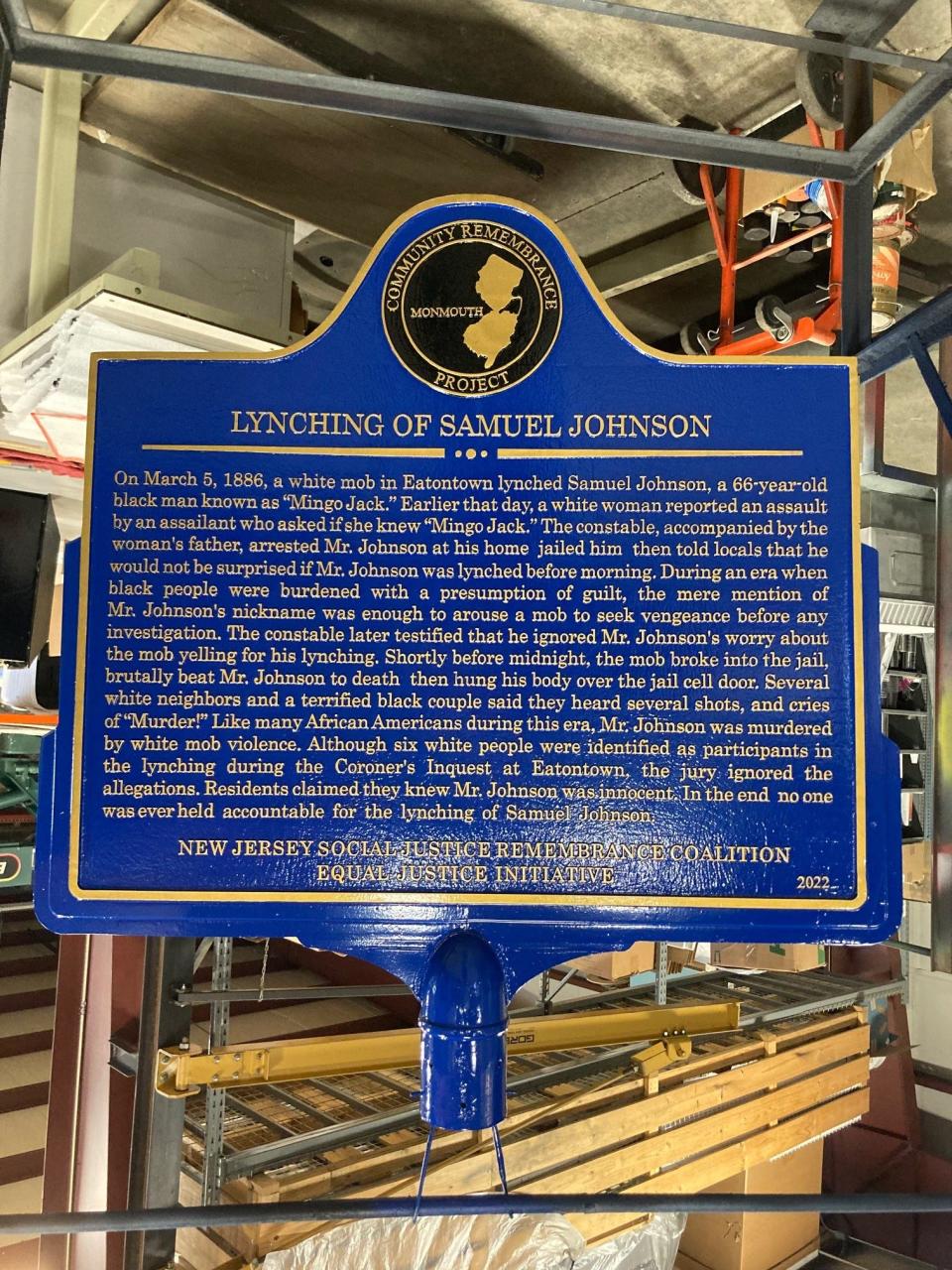Murder of Mingo Jack in Eatontown, NJ's only known lynching, won't be forgotten again
EATONTOWN - In 1886, Samuel "Mingo Jack" Johnson's life ended in a moment of terror, when a vengeful mob of white men lynched the Black man at present-day Wampum Park.
His screams pierced the night. His body was left hanging until a child found it the next morning.
He never got a trial for the alleged crime of which he was accused. His murderers got off scot-free.
This Saturday, 136 years later, an historical marker will be placed there to remind all of the events that took place on this ground. In the bigger scope of things, the historical marker will join a trail of markers that are being placed at documented lynch sites across the country.

Soil collection: Soil near Mingo Jack's lynching in Eatontown headed to museum in Alabama
Johnson is the only documented lynching to have occurred in New Jersey.
"I think what the marker does is bring attention and awareness that this happened in our own community. It's part of the larger national conversation taking place right now. We must strive together to ensure that these atrocities never happen again, lest we forget our history," said Pastor Terrence Porter of Pilgrim Baptist Church in Red Bank.
Porter chaired the local Historical Marker Committee that worked with the Equal Justice Initiative (EJI) based in Montgomery, Alabama, which is leading a national initiative called the Community Remembrance Project to place markers at lynching sites.
The committee also teamed with the borough and the New Jersey Social Justice Remembrance Coalition, which was initially founded to help document Johnson's story.
In 2010, EJI staff began investigating thousands of racial terror lynchings in the American South, many of which had never been documented. EJI's mission is not only to map the lynching incidents but understand the terror and trauma this sanctioned violence against the Black community created.
EJI has documented more than 4,500 lynchings of Black people in the United States between 1877 and 1950. Another 2,000 documented lynchings occurred during the Reconstruction years, between 1865 and 1877.
Monmouth's slavery past: Have you seen this burial site?
In October, EJI came to the borough and collected soil from Johnson's lynch site. One jar went to its museum the National Memorial for Peace and Justice where it was placed with other jars from other sites. Another jar will make its way to the T. Thomas Fortune house in Red Bank, which now serves as a museum honoring its namesake, a pioneer Black journalist, this month.
See a video from the soil collection ceremony at the top of this story.
Mingo Jack
A dozen years ago Eatontown resident Sondra Thompson heard local historian and author James Stone speak about Johnson at the eastern branch of the Monmouth County Library in Shrewsbury.
Already in her 70s, it was the first she had heard of him. There were no markers at the site and the story had been largely forgotten.
Slavery at the Jersey Shore: How some make sure it's not forgotten
Thompson then spearheaded the Mingo Jack Remembrance Committee, which was able to fund a large stone with a plaque to remember Johnson at Wampum Park. A gravel path was put down that leads to the old jail site on Wampum Pond where Johnson was hanged.
"We went everywhere. We did fundraisers, we went to planning board meetings, churches, Monmouth University, the Lions Club. I'm so happy it's finally being documented and getting the attention it deserves," Thompson said.
Juneteenth: Celebration coming to Freehold, Marlboro
Johnson, a 66-year-old Black man and former horse jockey known as Mingo Jack, was whisked away on March 5, 1886, from his home by Constable Hermann Liebenthal for the alleged sexual assault of a young white woman.
Johnson had a wife and five children. They never saw him alive again. He never had a trial.
That night an angry white mob broke into the two-room brick jailhouse on the banks of Wampum Pond where he was being held, beat him and lynched him.
In subsequent years, two white men confessed to the rape, though neither was charged. Likewise, no one was ever charged for lynching Johnson.
Saturday's commemorative event
While there are no known surviving images of Johnson, artist Rodney Bennett of Asheboro, North Carolina, created a portrait of him based on scant descriptions from newspaper coverage at the time and Stone's book, "The Murder of Mingo Jack."
Slavery at the Shore: Slave shackles discovered at historic Middletown home displayed in jarring new exhibit
Bennet said he was "intrigued" by the commission and created a depiction of Johnson's life as a jockey, farmer, husband and father. The portrait will also be revealed at the event 11 a.m. Saturday at Wampum Park on Broad Street.
Porter said Johnson may have some surviving distant descendants, but they were not able to track anyone down for the event. However, they did find descendants of the family that Johnson worked for who will be in attendance.
Juneteenth: Neptune, Asbury Park celebration, parade recognizes communities' shared history
The marker will placed about 75 yards from the site of the former jail house that held Johnson. The jail has long been removed.
When Jersey Shore native Dan Radel is not reporting the news, you can find him in a college classroom where he is a history professor. Reach him @danielradelapp; 732-643-4072; dradel@gannettnj.com.
This article originally appeared on Asbury Park Press: Eatontown NJ Mingo Jack lynching site gets historical marker

